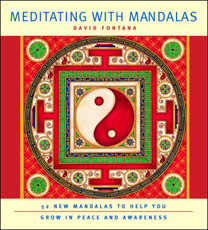"Mandalas are symbolic pictures used in meditation. Important in most Eastern traditions, they take the meditator on a wordless journey into the mind's deepest mysteries," writes David Fontana, who has been a practitioner of meditation for more than 30 years and is Distinguished Visiting Fellow at Cardiff University in the United Kingdom and the author of many books including Learn to Meditate and Discover Zen. In Hinduism, Buddhism, and Jainism, this sacred art form is a central feature of many meditation practices. Fontana traces the mandala tradition and the elaborate forms they have taken in many of the world's religions.
The simplest mandala is the circle, a capacious symbol that has no beginning and no end. The 52 mandalas in this beautifully designed paperback (one for every week of the year) offer a rich symbolic journey for anyone interested in self-exploration, stilling the body and the mind, or experimenting with the art of seeing. Fontana writes:
"The mandala is like a mirror that helps us to discover who we are. If the mandala is a suitable one, it is already a reflection of something deep inside ourselves, a reflection that does not judge or condemn, that does not flatter or deceive, that does not compare us with other people and find us better or worse, that simply reveals to us things as they are. When we stop to think about ourselves we become aware of all sorts of strengths and weaknesses, but the mandala is not interested in these. Like a mirror, it accepts all that it sees. It teaches us not to hide from ourselves. It teaches us to stop pretending that we are somebody we are not and to experience what it is to be ourselves rather than becoming lost in an artificial world of concepts, prejudices and needless hopes and fears about ourselves."
The 52 new full-color mandalas are divided into the following categories: sacred patterns, nature, self and acceptance, kindness and love, inner strength, and cosmos. Each one is accompanied by a guided meditation that draws out the multiple meanings of the symbols in the design. You can ponder the dove as an expression of peace, the salmon as a portal into intuitive wisdom, cranes as symbols of good fortune, or a snowflake as both fleeting and flawless.
